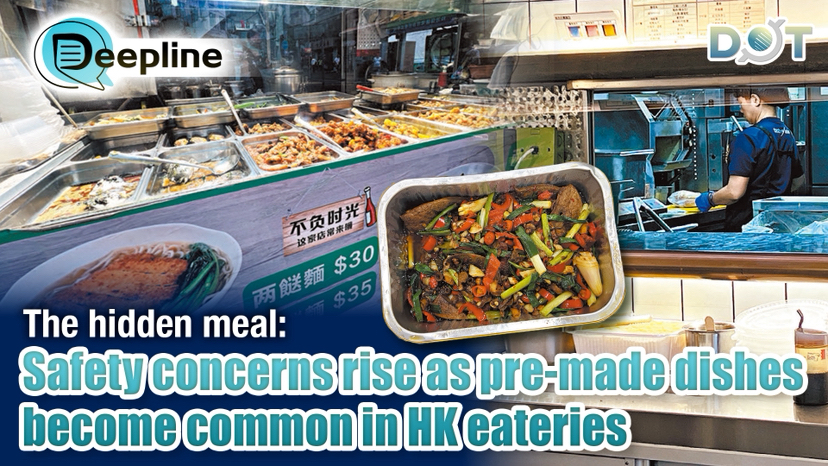
Pre-made dishes have quietly entered Hong Kong's catering industry in recent years. A Wen Wei Po reporter recently conducted random spot checks on four food items from chain cafés, dim sum restaurants, two-dish-rice shops, and local eateries. The items were tested for harmful substances like ammonia and nitrites, which can indicate prolonged pre-preparation.
How common is the use of pre-made dishes in Hong Kong's restaurants? The reporter earlier randomly interviewed diners, who all indicated that some pre-made dishes are noticeably different from freshly cooked food. Pre-made dishes often have a stronger taste, uniform cuts resembling machine processing, a loss of the original ingredient's flavor, and a different texture.
Diner Mr. Yip once tried a portion of tangyuan in a dessert shop and realized immediately upon putting it in his mouth that it was clearly pre-made.
"The reason was it lacked the springy texture; instead, it was mushy, as if it had been cooked for too long."
He pointed out that restaurants using pre-made dishes don't necessarily have lower prices. "For the same price, you could choose other restaurants. You only find out a place might use pre-made dishes after having a bad experience."
Hard to distinguish, still
Another diner, Mr. Lee, expressed that pre-made dishes are hard to guard against, as restaurants never disclose their food sources.
The reporter, based on a list of restaurants suspected of using pre-made dishes compiled by netizens, randomly visited four establishments. They purchased four takeaway items: chicken feet, minced pork patty rice, a pineapple bun, and stir-fried pig's liver, which were delivered to a laboratory on the same day for immediate testing.
While purchasing a pineapple bun at the chain café, during the wait, the reporter witnessed through the service window between the kitchen and the dining area a staff member in the kitchen openly pulling over a box of pre-made pineapple buns, taking one out directly from the box, cutting open its plastic bag, heating it in an oven, and then placing it into a takeaway box.
As for the two-dish-rice and dim sum restaurant, the reporter observed staff taking food directly from heated cabinets, indicating these items had been prepared some time ago. This was particularly evident at the two-dish-rice shop where many dishes were already sold out, with only small amounts remaining in some trays, suggesting they might have been stored for even longer.
To compare these foods with fresh ones, laboratory technicians used a plate of freshly blanched vegetables as a control sample. They then tested the difference in concentrations of ammonia and nitrites, which indicate freshness. The results showed that the ammonia concentration in fresh vegetables was below 0.001%, but it was significantly higher in the other four food samples, ranging from 0.89% to 3.42%. The minced pork patty rice had the highest ammonia content, 3,419 times greater than the fresh vegetables.
Expert: Long-term ammonia intake may cause chronic poisoning
Environmental scientist Dr. Homan Leung, interpreting the report for the reporter, pointed out that testing for ammonia and nitrites is commonly used to determine how long ago food was pre-prepared.
He explained that all food contains protein, which decomposes and produces ammonia. The longer food is stored or pre-prepared, the higher the ammonia content usually becomes. Long-term intake of ammonia may lead to chronic poisoning.
"However, the public need not be overly worried, as the human body can break down toxins. Chronic poisoning doesn't cause immediate illness; toxicity usually accumulates in the body over time before immune system problems appear. The risk can be reduced by not eating such food frequently."
But he stated there is no safety standard for ammonia – less is better.
Furthermore, all food, whether raw or cooked, contains bacteria. Refrigerating food only slows down bacterial growth rather than killing the bacteria directly. Bacteria attached to food decompose plant and animal tissues and produce nitrites. Higher nitrite concentrations indicate the food was prepared much earlier.
This round of tests showed the nitrite concentration in freshly blanched vegetables was 0.22ppm, but the concentrations in the other four samples ranged significantly higher, from 1.25ppm to 4.21ppm. The stir-fried pig's liver from the local eatery had the highest content, about 18 times that of the fresh vegetables.
Information from FEHD
A spokesperson for the Food and Environmental Hygiene Department (FEHD) stated that in the first three months of this year, the Centre for Food Safety (CFS) received one complaint about feeling unwell after consuming pre-made food, and the Centre has followed up on it.** There is a wide variety of pre-made foods. The CFS has issued safety guidelines for specific categories, such as ready-to-eat foods, poon choi, two-dish-rice, and cooked food products requiring cooling and reheating, for the industry's reference and application.
In 2024, the CFS tested approximately 66,900 samples, of which 110 failed the tests, resulting in an overall pass rate of 99.8%. The failed samples primarily included those non-compliant with regulations regarding metallic contaminants, pesticide residues, preservatives, veterinary drug residues, etc.; those where hygiene indicators and pathogens did not meet relevant safety standards; or pre-packaged foods that failed to declare allergens.
"Should not demonize pre-made dishes with one-size-fits-all approach"
Some catering industry practitioners believe the public should not demonize pre-made dishes with a one-size-fits-all approach. Some dishes, traditionally and even now, cannot be made fresh immediately. For example, bitter melon with spare ribs needs to be prepared a day in advance for the ribs to become tender and flavorful. However, dim sum items like har gow (shrimp dumplings) and siu mai (pork and shrimp dumplings) are relatively "delicate" and taste best when freshly made.
President of the Hong Kong Federation of Restaurants and Related Trades, Mr. Simon Wong, stated that pre-made dishes have been prevalent in Hong Kong for many years, with restaurants also using pre-made items. Furthermore, the COVID-19 pandemic severely impacted the catering industry's business, accelerating the development of pre-made dishes.
"During the pandemic, restaurant business declined sharply, and they couldn't afford to hire chefs. To sustain operations, many turned to pre-made food factories to reduce costs, avoiding the need to hire a large number of kitchen staff. Adopting pre-made dishes can significantly reduce a major expense, which is welcomed by some eateries."
He pointed out that the issue with pre-made dishes relates more to definition and standardization; they cannot be outright banned. Broadly speaking, canned goods, pickled vegetables, and cured meats are also forms of pre-made dishes. Additionally, the flavor of some foods comes from the pre-preparation process.
"Therefore, Hong Kong must follow the mainland's example by refining the regulatory definition of pre-made dishes, governing the use of additives, chemicals, and shelf-life requirements."
(Source: Wen Wei Po; Journalist: Lee Tsz-shan; English Editor: Darius)
Related News:




















Comment